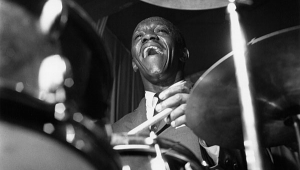| Columns Retired Columns & Blogs |
Beethoven's Diabelli Variations: the Finest Hour of Piano Music in the World Page 2
The setup used by Ray Kimber and engineer Graemme Brown for the possible SACD release was considerably more complex. As well as the four Neumann mikes, they also used two front-facing DPAs, just in case we changed our minds post-session. All six mikes were amplified by the Millennia preamp, which fed a multichannel EMM Labs DSD converter. The digital data from this Ed Meitner–designed unit were stored on a Genex GX9000 hard-disk recorder, with safety copies made simultaneously on three Tascam DS-D98HR digital DSD recorders. Cables were, of course, all Kimber, including Ray's impressive Palladium AC cords.

We had allowed a full day for testing the mike configurations and the position of the piano. While we could move the IsoMike array backward and forward in an arc as well as up and down, once we had settled on a good position for it, its bulk made it easier for us to fine-tune the recorded sound by moving the piano. Of course, Murphy's Law arranged that the position where the piano was best picked up by the mikes was right under the stage's fire curtain, meaning we had to reposition the piano before and after each session.

I was surprised by the "reach" of the IsoMiked Neumanns. Usually with omnis, you need to get in quite close to the sound source, to maintain a positive ratio of direct to reflected sound that they pick up. But with the IsoMike baffling, the omnis behaved more like directional mikes. We ended up with the front-channel mikes fully 18' away from the piano, looking down the line of the fully raised lid. Even then, the sound we ended up with is vivid rather than laid-back. Bob plays the piano hard, and that is what we were going for in the sound, rather than pushing the instrument back into the rather anonymous acoustic of the modern hall.
Back Home
With Bob back in Vancouver and me back in Brooklyn, we each spent the next few weeks listening—and listening. With nearly an hour of music in the Diabellis and another 12 minutes in the C-Minor Variations to produce from the eight hours of session files, we had a lot of listening to do. Bob likes to do complete takes as much as possible, but he is also a perfectionist, and we had redone a number of sections until they felt right to him. In fall 2004 Bob sent me an Excel spreadsheet with detailed notes on the takes for the first 10 variations. By the time I had assembled a first edit of these, Bob had sent me a spreadsheet with his notes on the next 10 variations. Thus we proceeded through the winter, until we had the backbone of the performance finished. In March 2005 Bob was able to spend some time with me during a trip East. We finished a second edit of the complete Diabellis and did an incomplete edit of the C-Minors.
And there the project sat for rather a long time. Not only did I have the second Cantus Christmas CD to edit and master, but I needed not to hear Beethoven for a while. The Diabellis are intense music. The transition from the lyrical stillness of Variation 31, through the bombastic fugue of Var. 32, to the resigned contemplation of Var. 33, for example, is one of the most sublime contrasts in all music, but it is not something I can listen to very often. Other than recording Bob's blistering performance of the Diabellis at Home Entertainment 2005 at the end of April, I needed to spend some time away from the work before I could give it anything like a critical listen. And by doing so, I would, of course, be following in the footsteps of the composer, who had put the set to one side for four years before completing it.
I returned to the project in December 2005. Bob had e-mailed me some thoughts on sections that he felt needed some more work. There was also an issue of tempo for Vars. 12 and 32, of which we had recorded two versions at slightly different speeds, and I needed to think about such matters as how to deal with extraneous noises throughout the work. The best take of Var. 24, for example, also included some distant thunder, and occasionally in other variations the piano softly creaked to itself. (When the instrument's soft pedal is depressed, the entire keyboard, which is made of wood, slides across the frame, also made of wood, so that the hammers hit just one of the two or three strings comprising each note.)
Slowly, I got back into the swing of things. I redid some troublesome splices, filtered the thunder, decided to leave the creaks as is—after all, this was the sound of a real instrument, not a synthesizer—and finished assembling the C-Minor Variations performance. At the end of February I sent Bob a CD-R of the provisional master and sat down to write these words. Bob's words on the music follow.
Our Variations CD costs $16.95 and is available from the secure "Recordings" page on this website. I hope you get as much pleasure from listening to it as I did from being involved in its genesis. My thanks to Robert Silverman for his extraordinary pianism, and to Ray Kimber for his help and hospitality.
Robert Silverman on the Music
In 1819, to advertise the fact that he had started a publishing company, the composer Anton Diabelli circulated a waltz he had written to 50 of Austria's best-known musicians, including Ludwig van Beethoven, Franz Schubert, Carl Czerny, one of Mozart's sons, a prepubescent Hungarian prodigy named Franz Liszt, and a host of other, lesser-known composers. Diabelli's intention was to publish them collectively and donate the proceeds to charity.
Beethoven refused to participate in the group effort, but offered to provide an entire set of his own. Diabelli jumped at the offer and planned to publish both sets simultaneously. Beethoven began work almost immediately, completing 23 variations quickly and, according to his not entirely trustworthy biographer Anton Schindler, enjoying himself immensely while doing so. Then, inexplicably, and quite uniquely for his larger projects, he set the piece aside for four years.
During this period he completed the Missa Solemnis and the last three piano sonatas. Only then did he return to the Diabelli project. He composed ten more variations, elaborated the final one significantly, and dispatched the set to Diabelli in 1823. The newer variations do not appear as a single group—in fact, Vars. 1 and 2 date from the later phase. Still, most of the newer variations do appear toward the end of the work, and they give the set a shape and complexity it did not have in 1819. Overall, as the work progresses, the waltz now seems to undergo a process of deconstruction to the point where it is literally pounded into particles in Var. 28 before undergoing a painful rebirth in the final five variations.
From the moment they were published, the Diabelli Variations were acknowledged as a masterwork. Anton Diabelli himself was the first to proclaim that they deserve a place beside Bach's Goldberg Variations. Hans von Bülow called them a "microcosm of Beethoven's art," Donald Tovey wrote that they are the "greatest of his variation works," while Alfred Brendel terms them "the greatest of all piano works." I concur: If a finer hour of continuous piano music exists, I have not heard it.
Yet for many musicians and experienced listeners alike—not to mention some performers—maintaining one's concentration through almost 60 minutes' worth of some of the most intense music-making ever devised is admittedly difficult. I occasionally wonder if audiences clap not only for the performance, but also for their own achievement of sitting through it, for Beethoven made no effort here to achieve the kind of popularity that greeted the "Moonlight" Sonata or the Fifth Symphony. There is no obvious narrative of the sort found in larger forms, such as the sonata or symphony. The joy of these variations—and they are largely joyful; this music was never meant to be a religious tract—lies not in the extramusical sensations and impressions Beethoven often can evoke in his listeners, but in the fantastic play of the notes themselves.
In the Classical and early Romantic periods, most composers routinely tossed off decorative sets of variations based on popular folk or opera tunes, usually for quick commercial gain or to curry favor with a wealthy patron. However, only the finest masters could surmount the difficulties involved in composing a serious set of variations. These composers generally wrote the theme especially for the occasion, ensured that the variations did not run together endlessly, and did more with the theme than simply embellish the melody with increasingly faster figurations. And if occasionally they were intent on creating a magnum opus, as Bach did in the Goldberg Variations, they took special care in its overall organization.
At first glance, the Diabelli Variations seem to exhibit remarkably few of those attributes. The theme itself is hardly a masterpiece; Beethoven did not think much of it at first, referring to part of it as a Schusterfleck (cobbler's patch). The Diabellis also constitute the longest piece for solo piano in the standard repertoire. Moreover, there are portions of the piece where any audible sense of continuity seems largely absent.
Beethoven did not even title the work "Variations" (in German, Variazionen). Rather, he followed Bach's example in the Goldberg Variations by choosing the unusual term Veränderungen, which the native German-speaking Alfred Brendel translates as alterations. Some musicians, in fact, have even suggested that the entire opus is not necessarily a single work, but rather a series of individual bagatelles, or small groups of them, all based on Diabelli's waltz.
- Log in or register to post comments



































